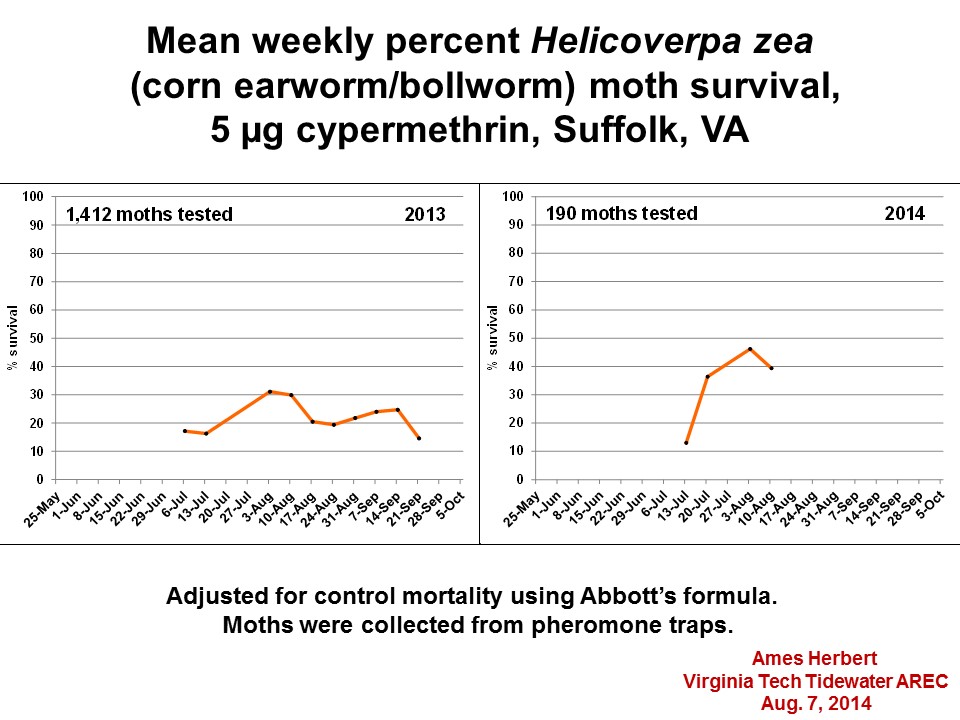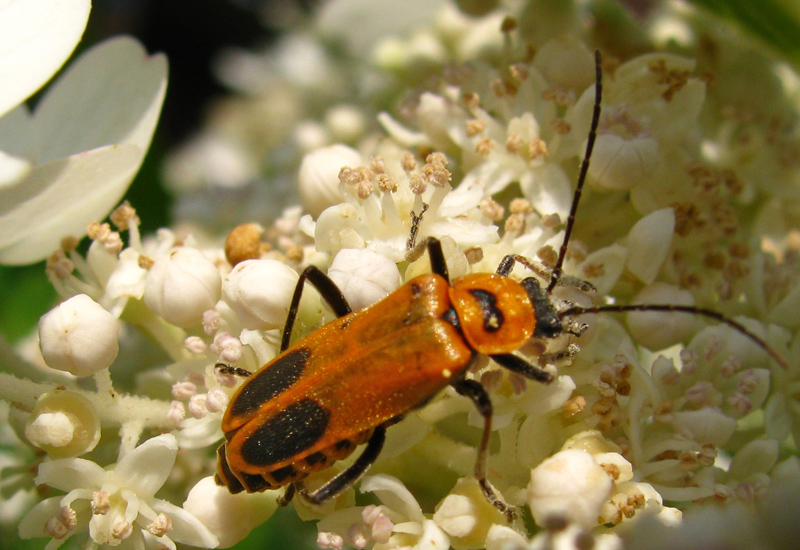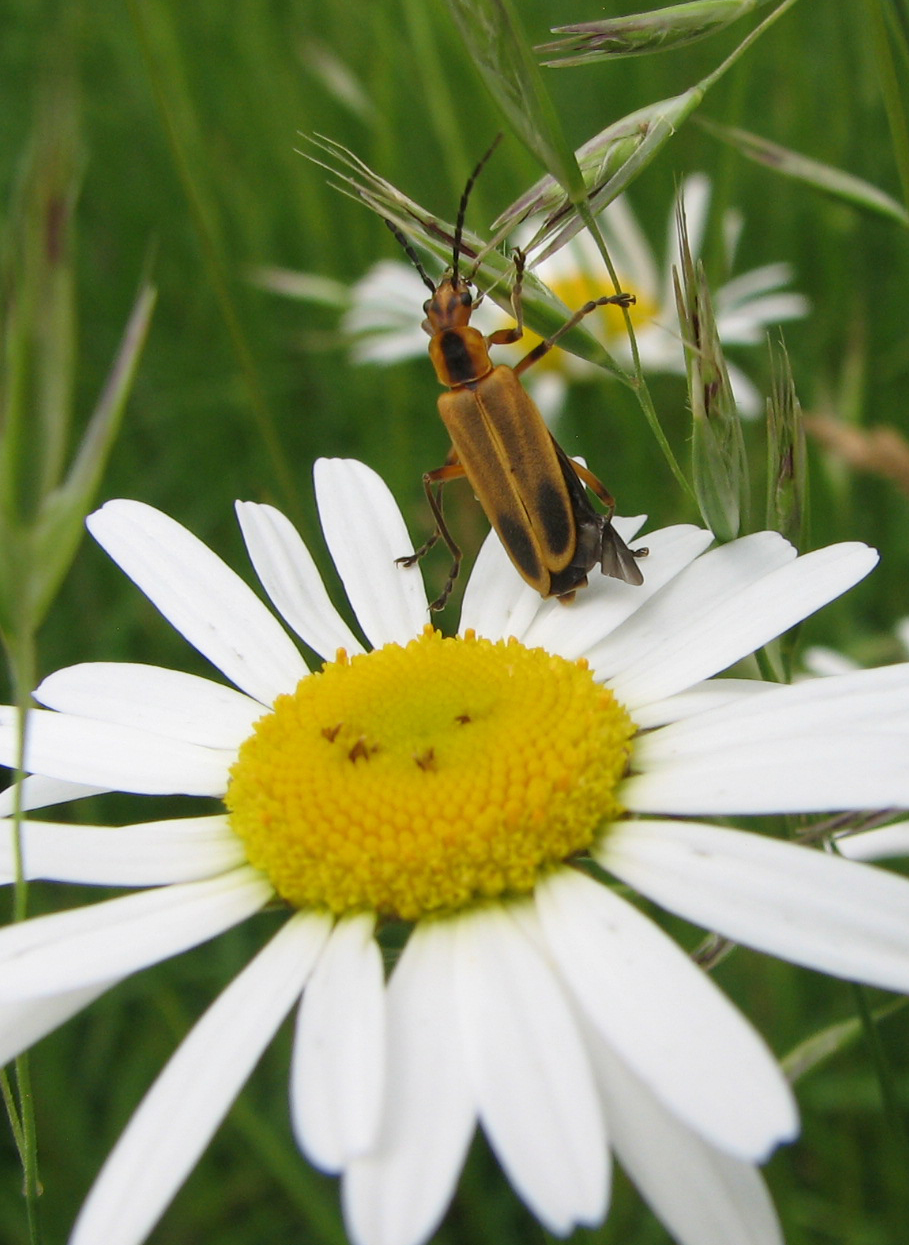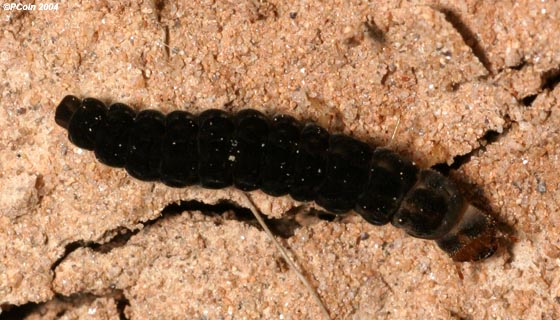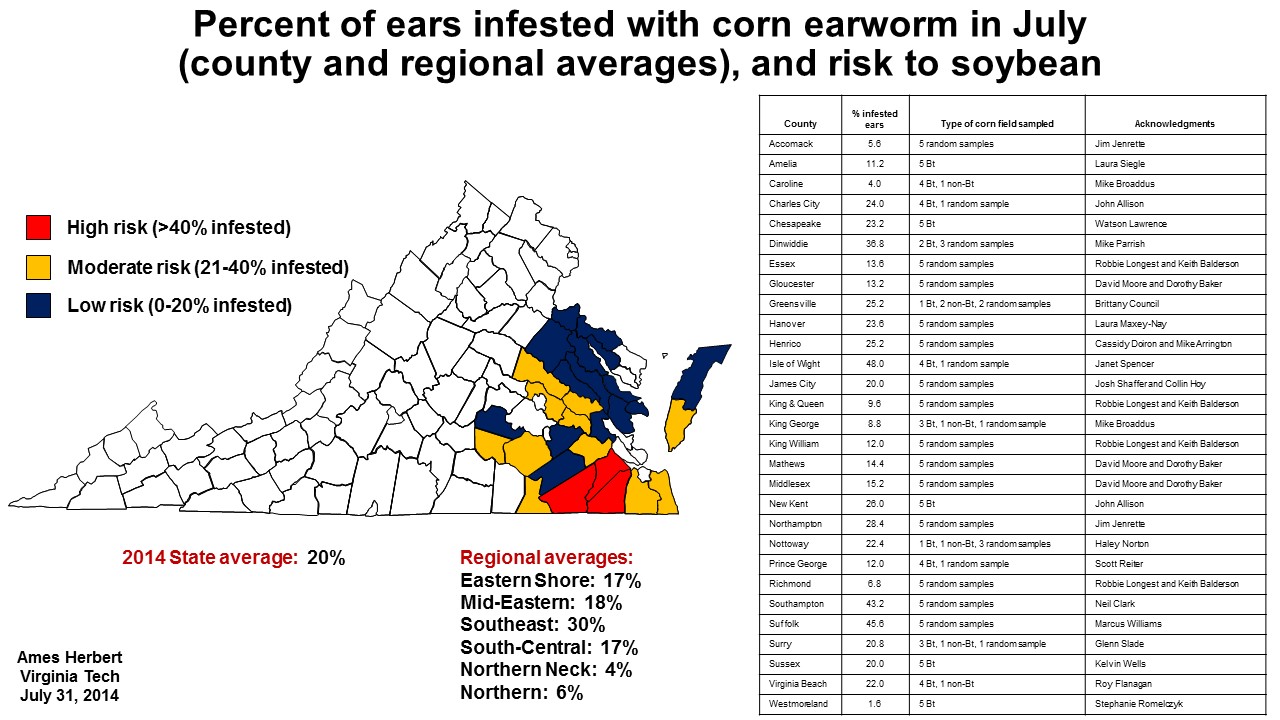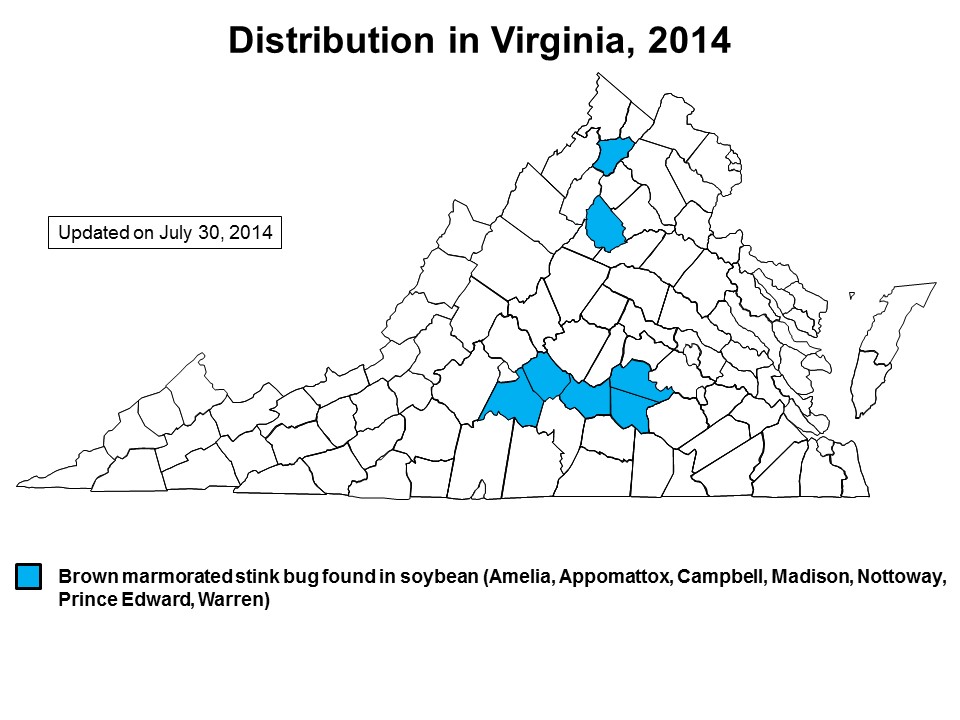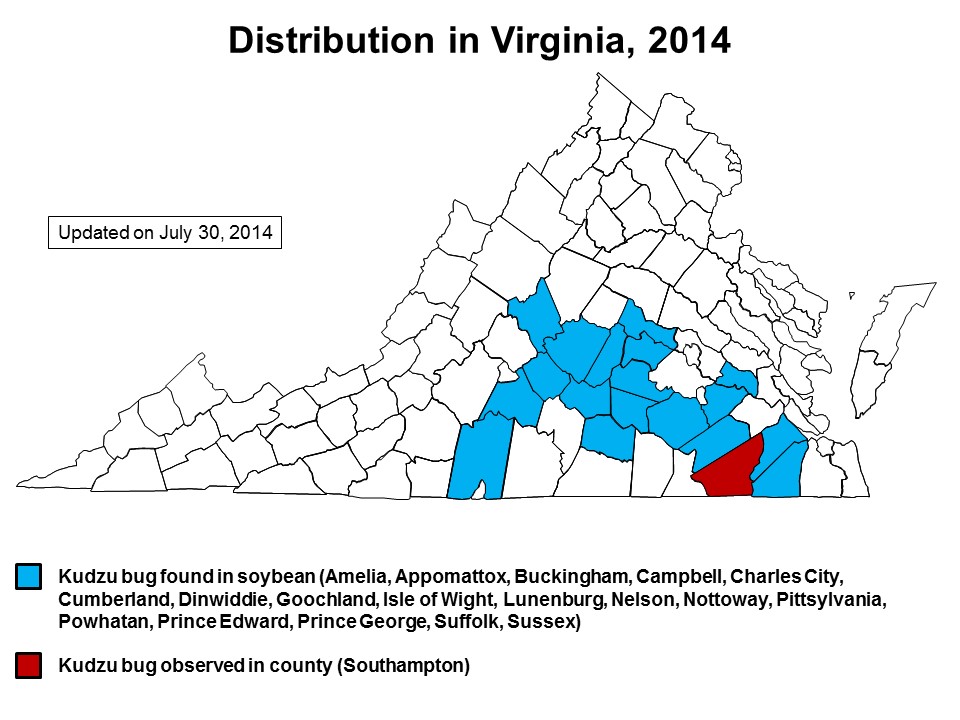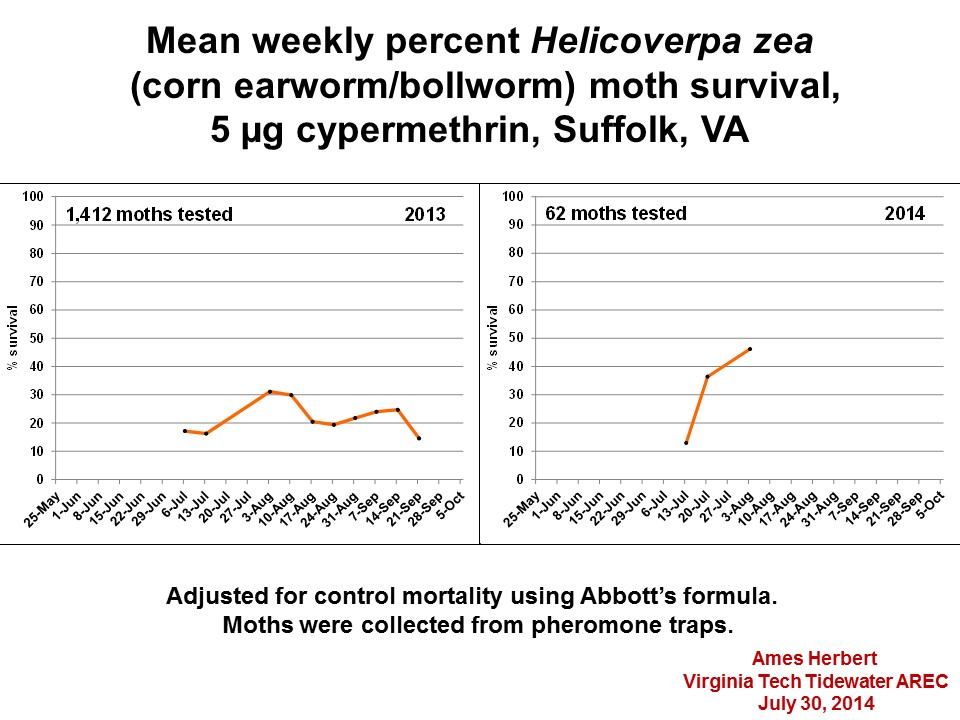Our corn earworm/bollworm moth catches went up this week allowing us to conduct adult vial tests on 128 moths. Vials were treated with the standard 5 microgram rate of cypermethrin (a pyrethroid insecticide), or acetone (the untreated check). This week, 39.4% of moths survived the test, which is high. The season-long average is now 35% survival (based on 190 moths evaluated) and is higher than what we saw in 2013 (see graphs, below). Survivorship at this level indicates that non-pyrethroids may need to be considered when an insecticide is needed for this pest in some regions, so please keep this in mind when scouting and then making management decisions in the upcoming days.
Category Archives: Insect
Predator profile: Leatherwings (soldier beetles)
Beetles in the family Cantharidae are referred to as soldier beetles or leatherwings. Two species in the genus Chauliognathus are commonly found in Virginia agricultural fields. Chauliognathus pennsylvanicus is often referred to as the Pennsylvania leatherwing, or the goldenrod soldier beetle referring to its favorite flowering plant in the fall. A similar species Chauliognathus marginatus, the margined leatherwing, is found in the spring on various flowers.
Pennsylvania leatherwing beetle (above).
Margined leatherwing beetle (above)
Description and Life History
Though soldier beetles resemble fireflies, they lack the light-producing organ on their abdomen and their head is not concealed from above. Cantharid beetles in general are elongate with soft and flexible elytra. The two Chauliognathus species range in size from 1/2 to 5/8-inch long, and have yellowish to orange elytra. Pennsylvania leatherwing has two prominent brown-black spots near the tips of the elytra and a black spot in the center of the pronotum. In contrast, the elytra of the margined leatherwing can vary considerably in the amount of dark markings and the dark marking on the pronotum is a band that reaches both the front and the back edge. Another way to differentiate these two species is the time period that the adults are present; Pennsylvania leatherwing adults are active in the fall and margined leatherwing adults are active in the spring. This is also important in regards to conservation biological control as flower resources need to be available in early spring for one species, and in late fall for the other.
Leatherwing beetles have one generation per year. Adults of both species typically feed and mate on flowers. Eggs are deposited in clusters in the soil, and hatch in ~10 days. Tiny neonate larvae are white-colored and display little or no activity until first molt. After about 24 h, they take on C shape. With each successive molt, the larvae darken in color until eventually reaching a black velvety appearance. Activity also increases as the larva develops. Leatherwing larvae are voracious predators consuming a multitude of soft-bodied insects. A single predatory larva can consume several egg masses of Colorado potato beetle, or aphids, or small lepidopteran larvae in one day. In the lab, they feed upon many different prey species.
Black light trap catches for the week ending July 31, 2014
Corn earworm moth catches were low this week, with nightly means ranging from zero to two moths. Brown marmorated stink bug captures were low in all locations except Petersburg (with approximately 20 per night). Please click on the link below that says “BLT_7_31” to see the Tables for detailed captures of these two pests. Thanks to the following for their reports this week: Mary Beahm, Chris Drake, Scott Reiter, Keith Balderson, Mark Kraemer, Janet Spencer, and Ames Herbert and his entomology team.
Results of the Corn Earworm Survey in Virginia Field Corn—2014
Annually, we conduct a survey to estimate Helicoverpa zea (corn earworm) infestation levels in field corn in mid- to late July. Corn is considered a nursery crop for corn earworm, allowing the pest to complete a lifecycle and then move on to other crops such as soybean, cotton, and peanut in August. Over 30 years of data show that there is a linear correlation between the infestation level in corn and the amount of soybean acreage that gets treated with insecticide for this pest.
To conduct the survey this year, the number of corn earworms found in 50 ears of corn was recorded in 5 corn fields in each of 29 counties, totaling 7,250 ears and 145 fields sampled. When fields were known to contain Bt or non-Bt corn, this was noted. Otherwise, samples were considered to be random and assumed to be representative of the actual Bt/non-Bt composition in each county. Age of corn earworms, or if they had already exited the ears, was also recorded (data not shown). We greatly appreciate the help of Virginia Cooperative Extension Agriculture and Natural Resource (ANR) Agents, Virginia Tech faculty and staff, and volunteers in this effort. These cooperators are acknowledged in the attached Figure. We also would like to thank the many growers who graciously allowed us to inspect their fields for corn earworm.
Results of the survey are provided below (click on the Figure to enlarge it). Statewide, approximately 20% of ears were infested with corn earworm. For comparison, 18% of ears were infested in 2013, 30% in 2012, 33% in 2011; 40% in 2010; and 36% in 2009. Regional averages for 2014 were 6% infested ears in Northern counties, 4% in the Northern Neck, 18% in Mid-Eastern, 17% in South-Central, 30% in the Southeast, and 17% on the Eastern Shore.
This survey is intended to be a representative sample, not a complete picture. We always recommend scouting individual fields to determine exactly what is happening in terms of corn earworm as well as other pests and crop problems. Also, please check the black light trap reports on the Virginia Ag Pest and Crop Advisory and other reports posted weekly to keep up-to-date on the insect pest situation.
Brown marmorated stink bug update for soybeans
As of this week, brown marmorated stink bug adults, nymphs, and egg masses are beginning to show in a few soybean fields in seven counties (Madison, Warren, Campbell, Appomattox, Prince Edward, Amelia and Nottoway). Number are still very low but more are expected as they move from border trees into fields. This early movement is coinciding with the maturity of the soybean crop. Most of the plants in the infested fields are in late R3-early R4 growth stages. When plants reach the R5 stage (seed fill), they will become even more attractive to stink bugs that target young seed to feed on.
Kudzu bug update for soybeans
The number of counties where kudzu bugs have been found in soybean fields has increased a lot since last week. Last week they were found in 4 counties and this week a total of 18 counties. In many cases both nymphs and adults are present. To my knowledge, none have reached the threshold for this second generation, that is, 1 nymph per sweep. Keep in mind that as much time as we put into this statewide survey of soybean fields, our scouts can only visit a small fraction of the fields. Our recommendation is that you check all of your fields. The best way is to use a standard sweep net doing several 15 sweep samples in a field. If you need a sweep net, here is one recommendation (there are several other sources): Bioquip, the sweep net with the 2 ft long handle, item #7625HS (https://www.bioquip.com/search/DispProduct.asp?pid=7625HS). Note that the site lists two handle lengths, again, we recommend the one with the 2 ft long handle.
Corn earworm update—slow to develop but some surviving the pyrethroid vial test
The corn earworm population is very slow to develop this year. We are only getting a couple of moths each night in our black light trap here at TAREC and our pheromone trap catches are way down compared to this time last year.
Sean Malone will be posting the results of our annual corn earworm field corn survey later this week. Those results, the percent of ears damaged by corn earworm, give us the best indication of what to expect in the coming weeks. Worms feed in corn, drop the ground to pupate in soil chambers, then adults (moths) emerge to fly to other hosts like soybean, cotton and peanut fields. So the size of the population in field corn is our first indicator of what the season may bring.
As in past years, we are also subjecting moths to the AVT (Adult Vial Test) with a pyrethroid insecticide. With the low population, mentioned above, we have not tested a lot of moths but the survivorship numbers are high 13-46 percent. I cannot forecast if this will increase as the season progresses, as it has in the past, but starting at this level is significant. Given these early results, regardless of the crop growers should be prepared to use some non-pyrethroid product ‘designed’ to target difficult to control corn earworms. These can be used alone, or tankmixed with a pyrethroid if other pests like stink bugs or kudzu bugs need to be controlled.
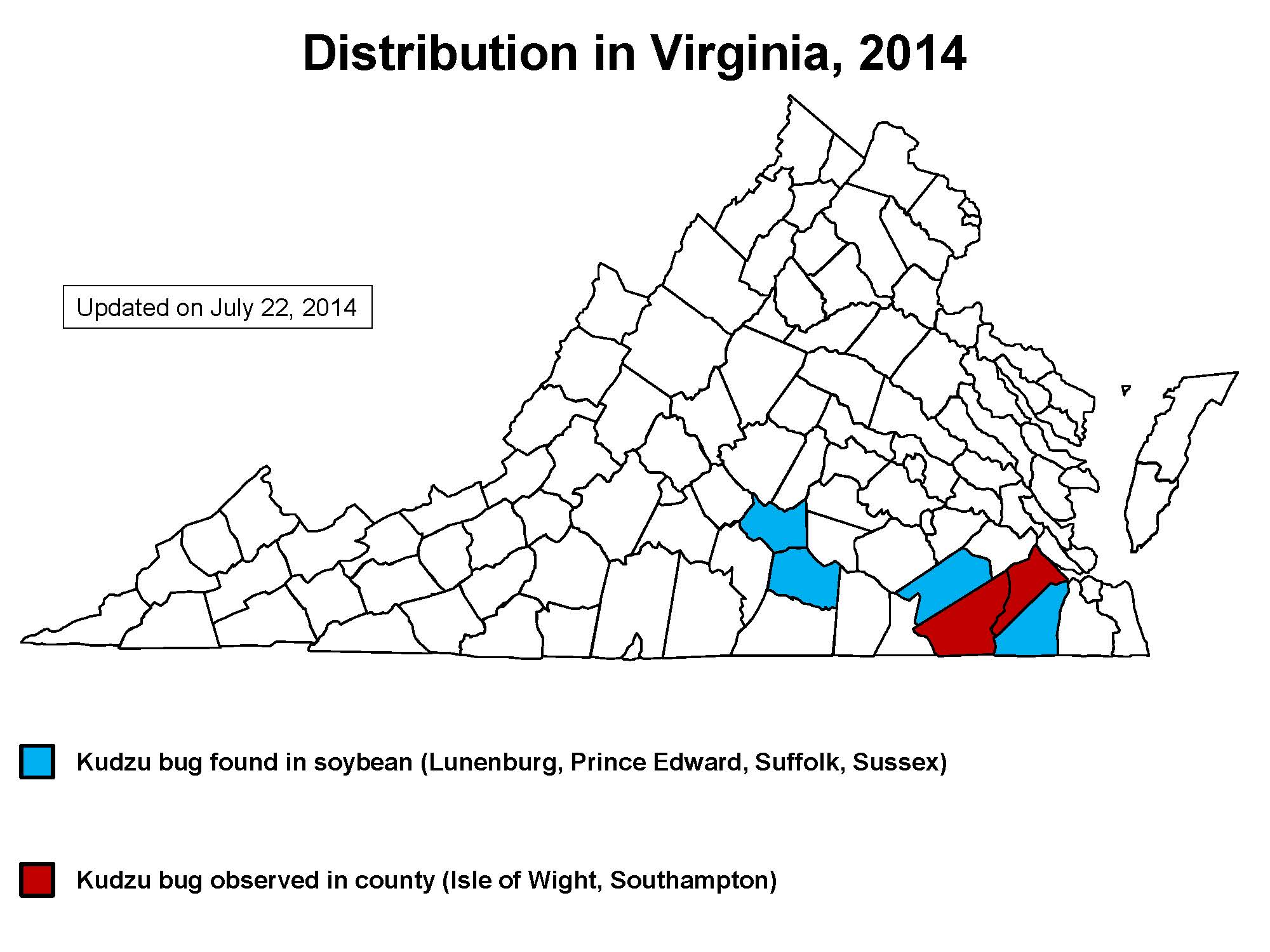
Soybean kudzu bug update—July 24, 2014
Our scouts have reported finding kudzu bugs in soybean fields in 4 counties. Nymphs as well as adults were found in two of those counties, Lunenburg and Prince William. Adults and nymphs were found in kudzu, only, in two other counties. All are near the southern border of the state. We are expecting this to change pretty rapidly so we strongly recommend that you start checking fields. This is most easily done with a sweep net. Go to several areas of a field, especially along the edges, and do several 15 sweep samples. At this point in the season, treatment thresholds should be based on the 1 nymph/sweep threshold.
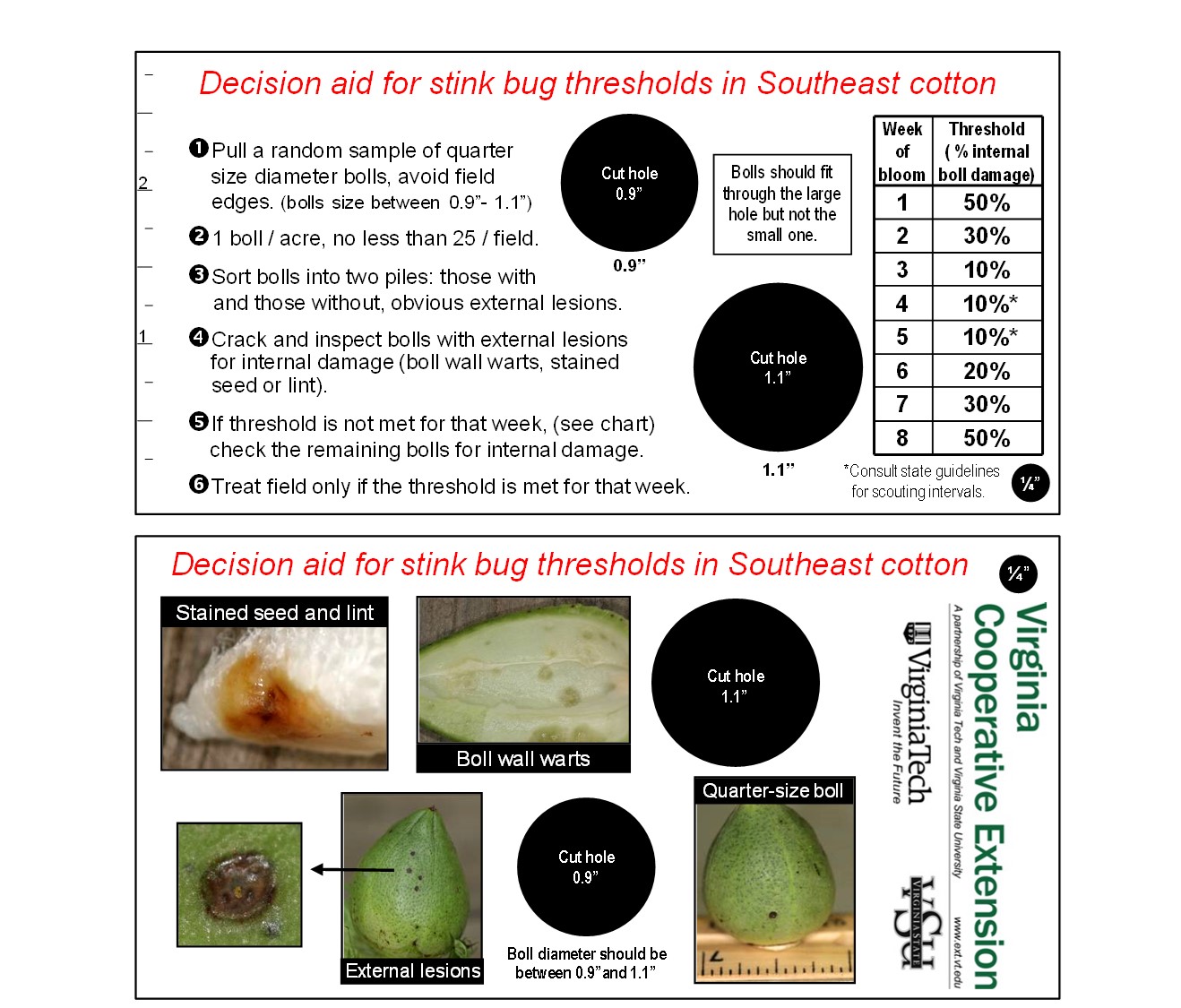
Cotton stink bug update—July 24, 2014
We are finding (and hearing about) a few cotton fields that have reached or exceeded stink bug damage thresholds—not all by any means, but some. For the most part, these are fields in the 3rd or 4th weeks of bloom. If you are following our recommended cotton stink bug thresholds, the threshold for the 3rd, 4th and 5th weeks of bloom is 10 percent internal stink bug damage. The research that these thresholds are based on showed that these weeks are the most critical for boll production and the bolls present during this period are the most susceptible to stink bug feeding injury.
If you have not started checking fields for stink bug damage to bolls, you might want to consider starting. In each field, pull a random sample of at least 25 bolls that fit in the ‘holes’ in our scouting card (contact us or your local extension office if you need a stink bug scouting card). Using bolls in this size range guarantees that you are sampling the right boll population. Crack each boll and inspect for internal stink bug feeding injury symptoms.
What products will give you the best control of stink bugs and longest residual activity? Our field trials, and others, show pretty consistently that pyrethroids and products like Bidrin provide the best control. Insecticides in the neonicotinoid class, if applied alone, are weak. Although products do a decent job of killing the adults and nymphs, none provide much residual activity —even 7 days would be a stretch. If adult stink bugs continue move in to field, more than one application may be needed.
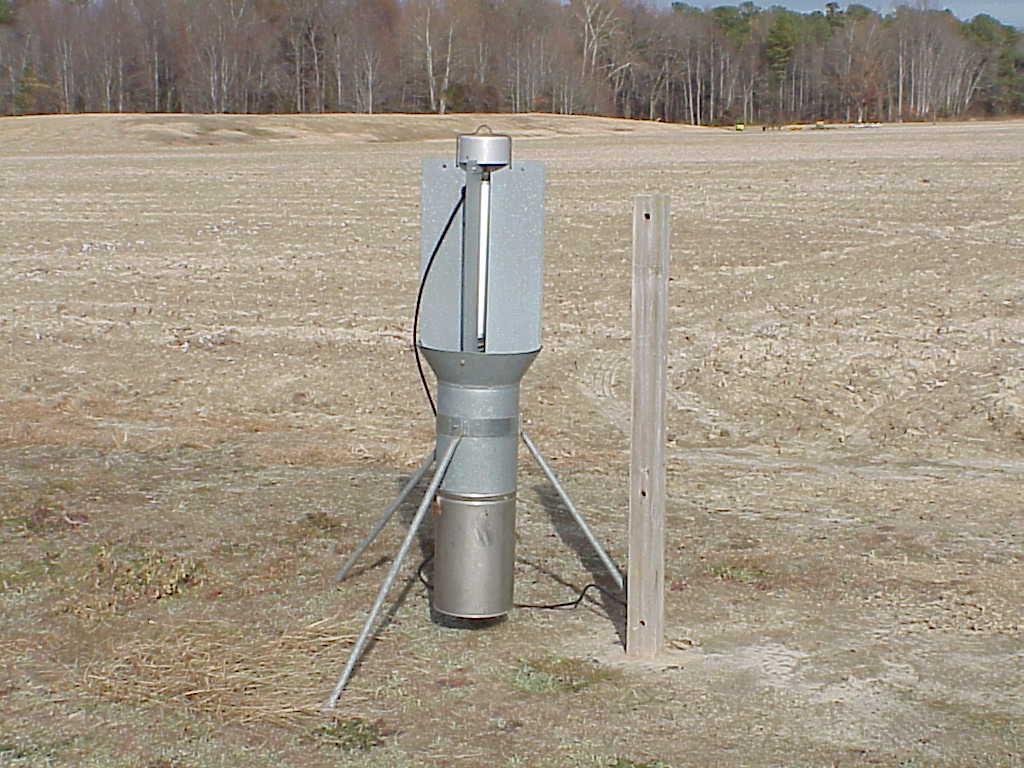
Black light trap catches for the week ending July 24, 2014
Nightly average catches of corn earworm moths in local black light traps were: Charles City=18.5; New Kent=8.0; Warsaw=1.0; Essex=zero; Petersburg=1.1; Eastern Shore AREC/Painter=zero; Hampton Roads AREC/Virginia Beach=zero; Southampton=3.0; Sussex = 1.9; Suffolk=2.5.
Means per night for brown marmorated stink bug were: Charles City=1.3; New Kent=zero; Warsaw=0.7; Essex=zero; Petersburg=26.9; Eastern Shore AREC/Painter=zero; Hampton Roads AREC/Virginia Beach=zero; Southampton=zero; Suffolk=zero. Thank you to our trap operators for their reports this week: John Allison, Mary Beahm, Keith Balderson, Mark Kraemer, Helene Doughty, Chris Drake, Kelvin Wells, and Ames Herbert and his entomology crew.

